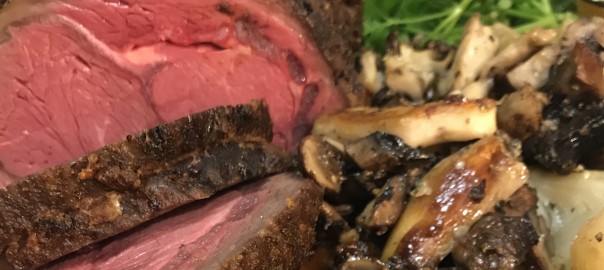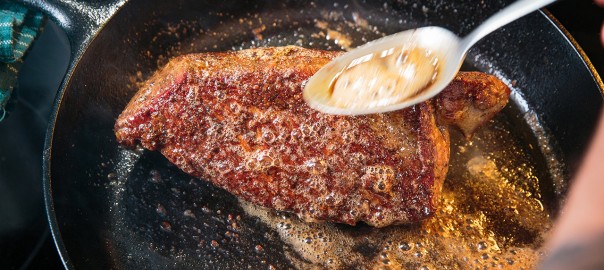Don’t miss a special Ribeye Roast recipe from ButcherBox Head Chef Yankel Polak at the bottom of this post.
Here at ButcherBox, we believe the best way to bring friends together is over a delicious cut of grass-fed, grass-finished beef.
Our favorite cut to share with others is the ribeye roast. Perfectly-cooked, the ribeye roast goes well with an array of side dishes, red wine, and good friends.
What exactly is a ribeye roast?
Ribeye roasts — and ribeye steaks — come from the rib section of the cow, as the name implies. Specifically, ribeye roasts come from between the sixth and twelfth rib. It is a well-marbled section of muscle that is comprised of the longissimus dorsi, complexus, and spinalis muscles of a cattle. Ribeyes come in a number of different cuts and go by a few different names.
Most ribeye roasts are large, boneless cuts that have generous marbling and are best cooked over a few hours time. Traditionally the cut was used only on special occasions; a beef ribeye roast would be coated with salt and ground black pepper, spend an entire day in a roasting pan, and then be sliced up and presented as Sunday dinner or the centerpiece of a holiday meal.
Some roasts come with the bones included, and in this form is called standing rib roast and sometimes prime rib. It can also, confusingly, be called prime rib without the bone, and to add a level of complexity can be referred to as a roast beef mainly because it is beef roasted in an oven. (Check out our piece on often confused cuts for some clarification on the difference between prime rib roast and ribeye steak.)
The ribeye can be cut into steaks and cooked on a grill — with or without the bone — and has enough fatty, flavorful marbling that it needs little more than a pinch of sea salt and black pepper to make it a tender, mouthwatering treat.
A section of the ribeye can also be further cut down into a hard to find cut of steak known as the ribeye cap. The cut comes from the most tender part of this large muscle known as the spinalis dorsi that is highly-sought-out by discerning steak aficionados. The cut also goes by other names across the globe, including “Scottish fillet” in its boneless steak roast form.
Enough about the details of the ribeye, let’s get to the important stuff: How to prepare a delicious ribeye roast.
How to cook a ribeye roast
You can order ribeye steaks from a butcher, or cut up a ribeye into steaks if you don’t want to put effort into roasting the cut. However, putting a little time and effort into the roast will pay off in the form of smooth, rich, well-marbled beef that you can easily slice up and serve to a number of dinner guests.
According to our Head Chef Yankel Polak, our ButcherBox boneless ribeye roast is a “breathtakingly marbled and tender hunk of meat.”
It can be prepared in numerous ways. For example, you can cook a ribeye roast in a slow cooker with some spices like fresh rosemary, minced garlic, and some vegetables. However, ribeye roast can be a bit too expensive to cook in this manner. “Pot roast,” beef usually tenderized by a day spent in a slow cooker is best with tough, less inherently flavorful cuts like chuck roast and shoulder steaks.
Below is ButcherBox Chef Yankel’s “Super Easy Ribeye Roast With Roasted Mushrooms and Eggplant.” This recipe serves eight, takes 20 minutes to prepare, and after two and half hours of cooking time, you’ll have a tender roast. It is quite simple and the perfect way to show off your cooking skills and delicious ButcherBox grass-fed beef.
The key is Chef Yankel’s use of a reverse-searing method, which allows you to sear the ribeye roast and let sit until it needs its final 15 minutes of cooking.
According to Chef Yankel, this will give you a medium-rare roast with a delicious brown crust. Also, he says, “This recipe won’t keep you stuck in the kitchen all night if you have guests.”
Super Easy Ribeye Roast With Roasted Mushrooms and Eggplant
Ingredients:
Beef Rub:
- 1 ButcherBox Ribeye Roast
- 3 Tbsp kosher salt
- 2 Tbsp garlic powder
- 2 Tbsp onion powder
- 2 Tbsp paprika
- 2 Tbsp olive oil
Roasted Mushrooms and Eggplant
- 2 lbs mushrooms, assorted variety, cut into similar size pieces
- 4 Japanese eggplants, halved lengthwise
- 6 garlic cloves, minced
- 2 shallots, minced
- 3 Tbsp fresh thyme, chopped
- 3 Tbsp fresh parsley, chopped
- 4 Tbsp extra virgin olive oil
- 2 Tbsp sherry vinegar (or red wine vinegar)
- salt and pepper to taste
Directions:
- Mix all ribeye rub ingredients and rub all over ribeye roast. Refrigerate on lowest shelf uncovered overnight. Remove from fridge 1 hr before roasting.
- Preheat oven to 250°F. Roast ribeye in a roasting pan until meat thermometer inserted into thickest part reads 115°F. Remove from oven and let rest for at least 20 min. The ribeye can sit out up to 2 hrs or be refrigerated until Step 7. If refrigerating, make sure to bring the ribeye back to room temperature before reheating.
- Preheat oven to 425°F.
- Mix all ingredients for the roasted vegetables except for the vinegar, then spread the vegetables evenly on sheet pans in a single layer.
- Roast vegetables in oven until lightly browned. Eggplant should be tender and mushrooms should shrink to half their original size.
- Remove vegetables from oven, sprinkle with vinegar and set aside.
- Place roast back in the oven and cook for an additional 15 min, until internal temperature is 125°F and the top is browned and crisp.
- Let ribeye roast rest for at least 20 min before carving. Happy Eating!
You can also check out Chef Yankel going through the steps of cooking a “Pan Seared Ribeye with Potatoes and Mushrooms”:






